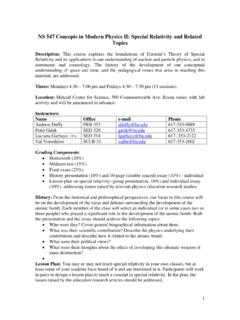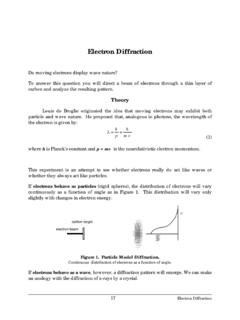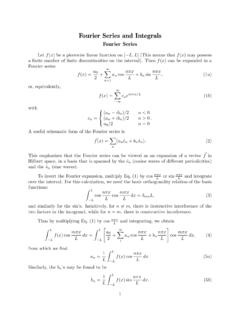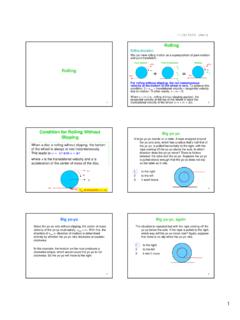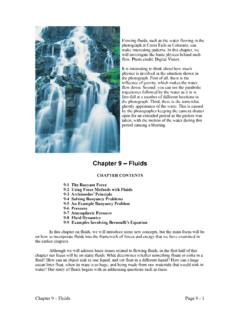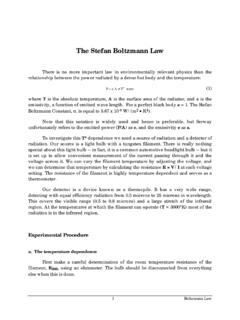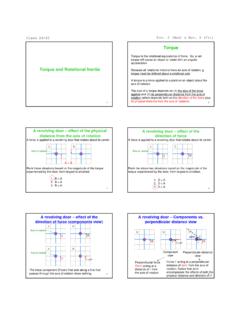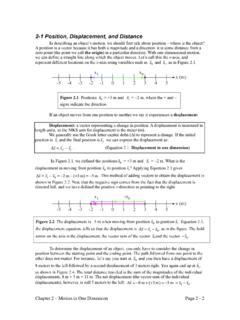Transcription of Momentum, Energy, and Collisions Microcomputer …
1 1 momentum , energy , and CollisionsMomentum, energy , and CollisionsMicrocomputer- based LabIn this experiment you will analyze various Collisions involving two carts on a track. Youwill determine whether momentum is conserved in each case, and whether kinetic energy ExperimentNote that in our setup the motion sensors are mounted at the ends of the SensorMotion SensorCartsTrackTo InterfaceTo InterfaceMomentum and energy in CollisionsTheoryThe momentum of an object is its mass multiplied by its velocity. momentum is a vector,so the direction is 1: In this experiment the motion is one-dimensional.
2 How can you account for thedirection of momentum in this case?The kinetic energy of an object is given by KE = mv2. Kinetic energy is not a vector,so you don t need to worry about 2: In this experiment you will be determining whether momentum and kineticenergy are conserved. What does it mean for a quantity to be conserved in a collision ?There are several types of Collisions to investigate in this experiment. These are: Super-elastic, in which kinetic energy is larger after a collision . Elastic, in which kinetic energy is conserved.
3 Inelastic, in which kinetic energy is lost. Completely inelastic, in which the objects stick together after the , energy , and CollisionsPROCEDURES imilar to how a bat navigates, the motion sensors used in the experiment measure theposition of the carts by bouncing ultrasonic waves off them. If your position graphs are notsmooth, check to see whether the motion sensors are picking up stray reflections from you orfrom other objects placed close to the I Preliminary that the motion sensor at the left end of the track is connected to the Dig/Sonic 1 porton the Vernier interface.
4 The motion sensor at the right end should be plugged in toDig/Sonic 2. It is very important that the track is horizontal levels are available for you tocheck You should have two different carts, one with a plunger and one without, as well as oneblack mass. Each of these items has a mass of about 500 g, but you should weigh The motion sensors have a limited range, so all Collisions should take place at the center ofthe track. In Collisions where one cart is initially stationary, this is easily accomplished byplacing that cart at the center of the Place the two carts at rest at the center of the track, stuck together by their Velcro your hands clear of the carts and click.
5 Click on All Sensors to zero bothmotion sensors. This will establish the same coordinate system for both sensors. Check thatthe zeroing was successful by clicking and rolling the still-linked carts back andforth on the track. The graphs for each motion detector should overlap for a 30-40 cm rangenear the center of the track. If not, repeat the zeroing 3. Is the positive direction to the left or to the right in this experiment?5. To determine the effect of friction in the experiment, record one cart as it rolls along thetrack from left to right.
6 To do this, click and then give the cart a push toward thecenter of the track. You should see a graph of the cart s position as a function of time, andanother showing its velocity as a function of time. The position graph will generally besmoother than the velocity graph, so we ll use the position graph to take measurements. Tomeasure velocity from the position graph, click and drag with the mouse to select a smallregion. Click the Regression button, . A box will pop up with several checkboxes theonly box checked should be the one corresponding to the graph you re interested in.
7 HitOK. The velocity of the cart is the slope of the position graph, which is the m 4. Measure the cart s velocity at two or three times separated by about do you observe? Is momentum conserved in this situation? Does the Law ofConservation of momentum apply here? , energy , and CollisionsIn trials 1-9 one cart is initially stationary. If you start the second cart to the left of thestationary cart, the graphs labeled 1 will apply to the stationary cart and the graphs labeled 2will apply to the second try to stop the carts from rolling into the motion sensors after the spring-loaded plunger on the plunger cart can be armed by pushing it in and pulling can then be triggered by striking the pin above the plunger with one of the black II Collisions using magnetic bumpersTurn the plunger cart around so its magnetic bumpers face the second cart (we ll call thatthe collision cart).
8 In the Collisions involving the magnetic bumpers, be careful that the carts donot actually make contact. In other words, the initial speed should not be too large. For eachtrial, record the mass of each cart, and the velocity of each cart before and after the collision . Trial 1 Equal masses. With no extra mass on either cart, place a cart at the center of thetrack. Click and then roll the second cart toward the first. You should see a positiongraph and a velocity graph for each cart. Measure four velocity values the velocity of eachcart just before the collision , and the velocity of each immediately after the measure each velocity, select a small region of one graph either just before or just after thecollision.
9 As you did in part I, use the Regression button, , to find the slope, which is thevelocity. You ll need to do more than once to find all the velocities you need, selecting theappropriate graph or graphs each time. Note that you can use the velocity graph to help youselect an appropriate region on the position graph. Trial 2 Stationary cart has more mass. Place the black mass on the cart that is initiallystationary, and repeat the experiment. Trial 3 Stationary cart has less mass.
10 Move the mass to the cart that is given the initialpush, and repeat the 5. The equal mass collision with the magnetic bumpers is a special case. Do younotice anything special about it, compared to the Collisions between unequal masses?Part III Collisions using Velcro bumpersTurn the plunger cart around again so its Velcro bumpers face the collision cart. Theplunger should be all the way in. In these Collisions the two carts should stick together after thecollision. Trial 4 Equal masses.
